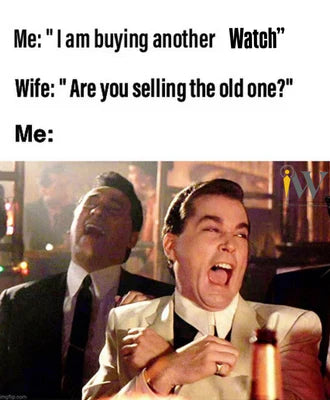Open Instagram and you'll see memes that nail our hobby: "I said it was the last one but then the new GMT dropped." We laugh because it's true. But, why do we keep going back for another watch? The answer lives inside our heads with a tiny chemical called dopamine.

Instagram Memes Are Telling on Us
You know the drill: a meme shows a Submariner next to the caption, “Told my wife it was the last one…”. We laugh because the punch line is painfully accurate. Under that humor sits a real psychological loop that makes scrolling → craving → buying feel almost automatic. That loop? It starts with dopamine.
Meet Dopamine, the “Anticipation” Messenger
Dopamine is a chemical in your brain that spikes before you get a reward, not just after. Neuroscientists call this a reward prediction error: dopamine helps the brain track the gap between what you imagine and what you get. That first rush happens when you:
- spot a new release,
- picture it on your wrist,
- imagine the experience or compliments.
Buying the watch closes the loop—if the experience matches expectations, dopamine levels stabilize. But if the payoff is underwhelming, the dopamine dip can make the excitement fade by the next morning.
Why Satisfaction Shrinks: Hedonic Treadmill
The Hedonic Treadmill idea states that people tend to return to their own base level of happiness after significant events. It's basically the scientific term for getting used to good things.
Studies show the happiness bump from a hedonic buy (like a luxury watch) is real but brief. Eventually, your new grail feels normal, and your brain starts scanning for the next thrill. Thus, you find yourself still on the treadmill.
Six Forces That Keep the Cycle Spinning
- Reward Chemistry: Dopamine makes “add to cart” feel exciting.
- Identity Stories: Each watch signals who you are—or want to be.
- Tribe & Likes: Wrist‑shots rack up validation; every “like” gives a mini dopamine buzz.
- Scarcity & FOMO: Limited editions exploit our fear of missing out.
- Investment Excuse: Rising resale values lets some buyers re‑label craving as “smart investing.”
- Adaptation: The thrill fades, so you chase a fresh one.
When Your Heart Beats Louder Than Your Wristwatch ❤️🔥
| What Happens | What It Feels Like | Why Your Body Does It |
|---|---|---|
| Pupils widen within 200 ms | Screen suddenly looks brighter, watch photos “pop” | Your eyes let in more light when you see something rewarding. |
| Heart rate bumps 3‑10 bpm | Tiny chest flutter—like approaching the top of a roller coaster | Adrenaline primes you to act (“click add‑to‑cart”). |
| Palms get warmer | You unconsciously reach for your phone or wallet | Blood flow shifts toward muscles used for grabbing. |
| Micro‑smile forms | A half‑grin you don’t notice until the selfie cam catches it | Dopamine lights up the brain’s reward center—your face leaks the news. |
How We Keep Collecting Simple and Healthy
- One‑In‑One‑Out: Sell a watch if you buy a new one.
- Track wrist time: Move on from watches you rarely wear.
- Phone a friend: Share big purchase plans with a trusted collector friend.
Your brain will always whisper just one more. Knowing why helps you choose instead of react. Laugh at the
memes, enjoy the hunt, and decide when it's true love and when it's just chemistry.
